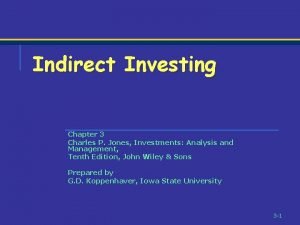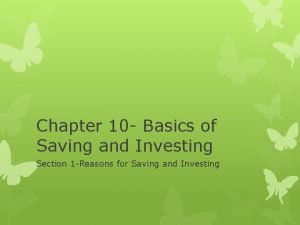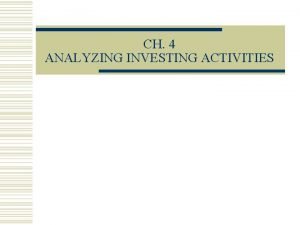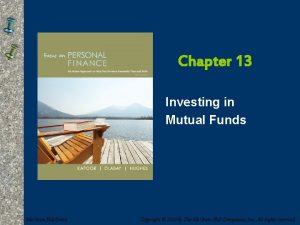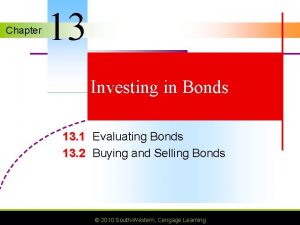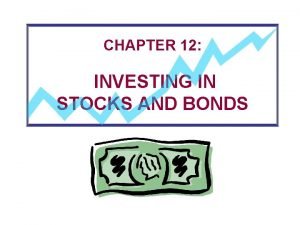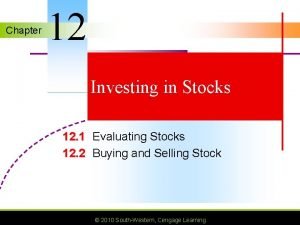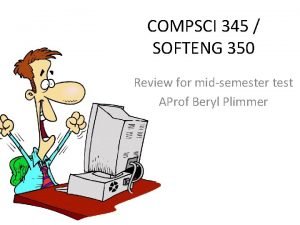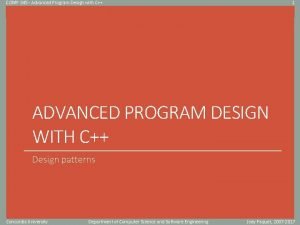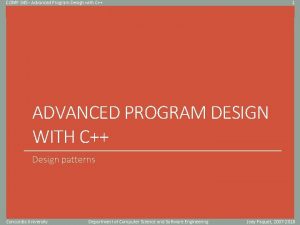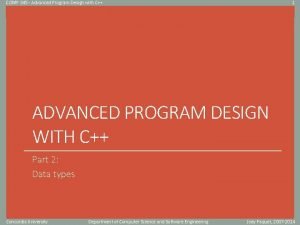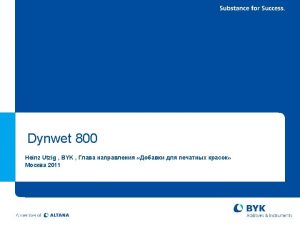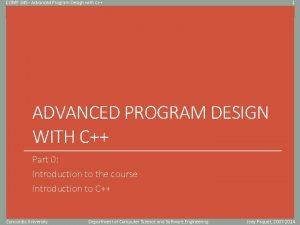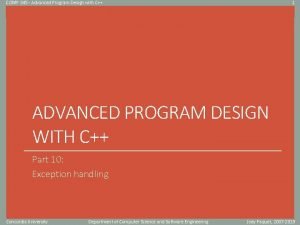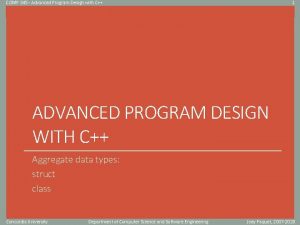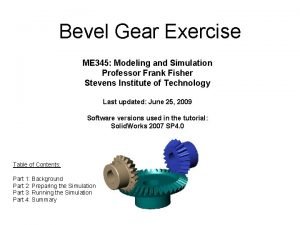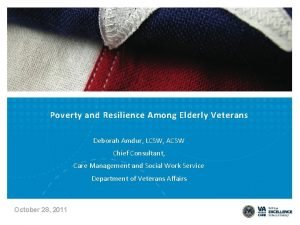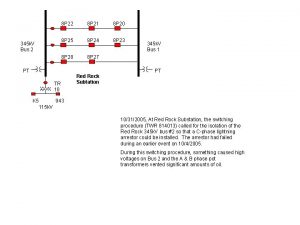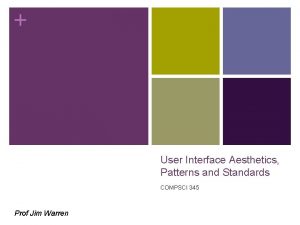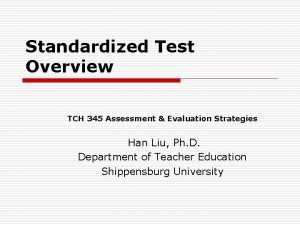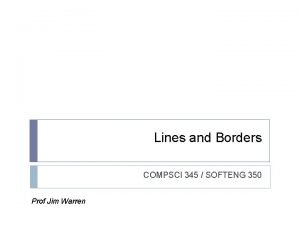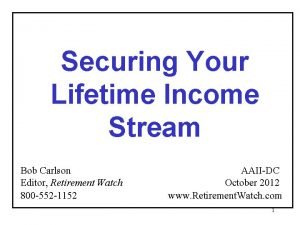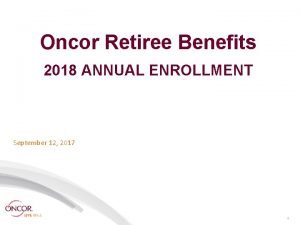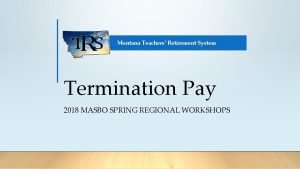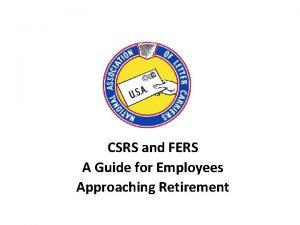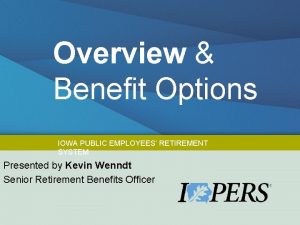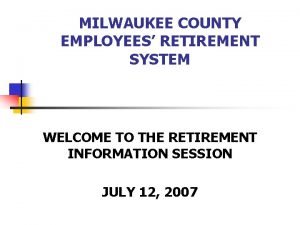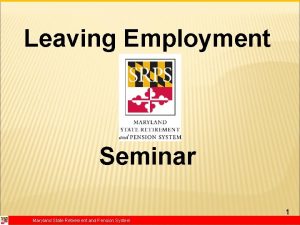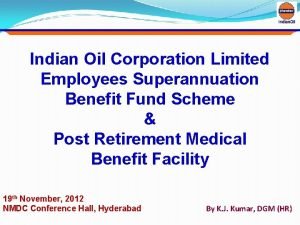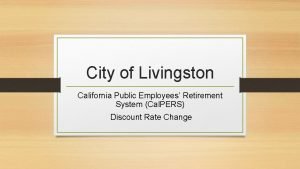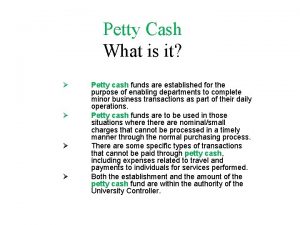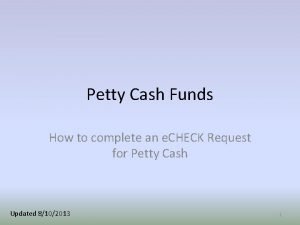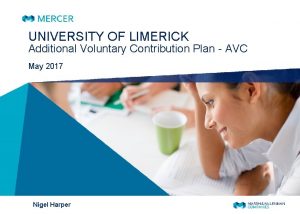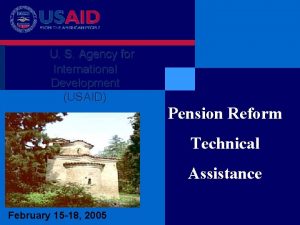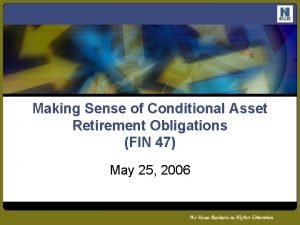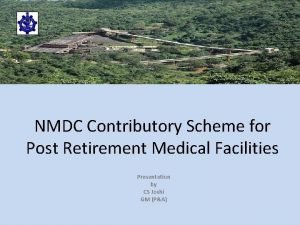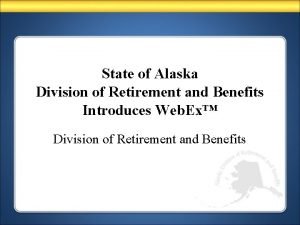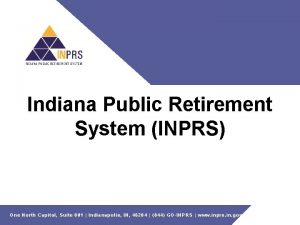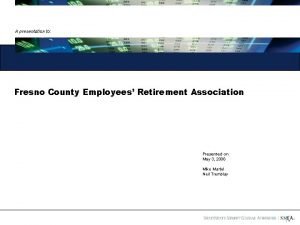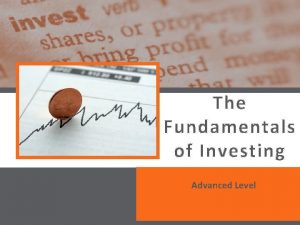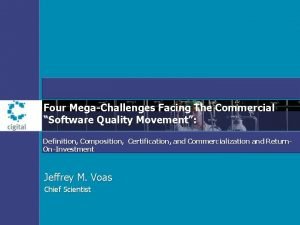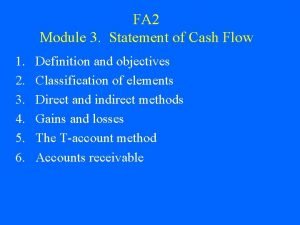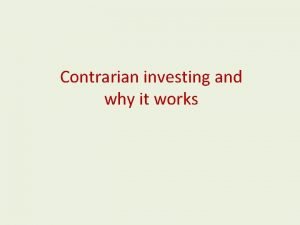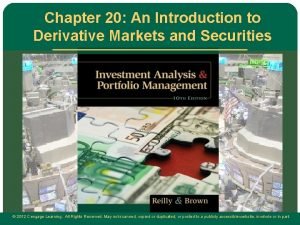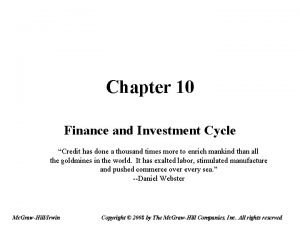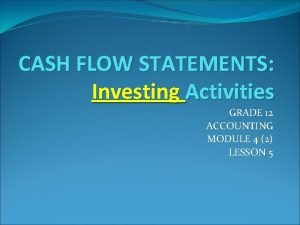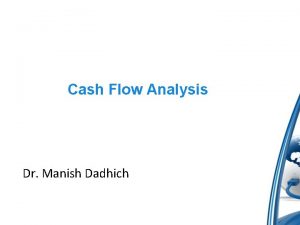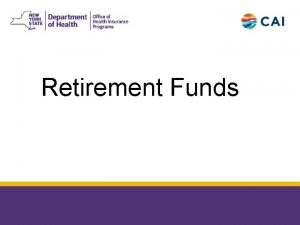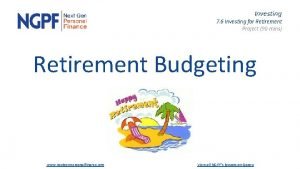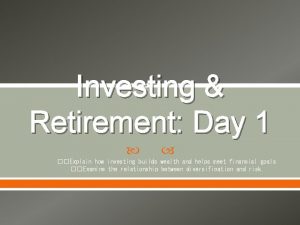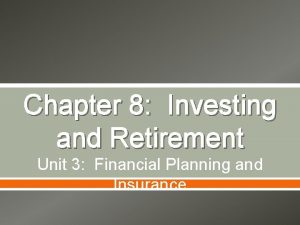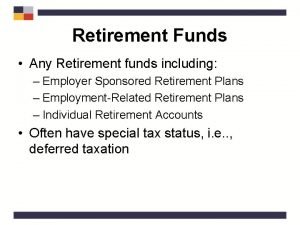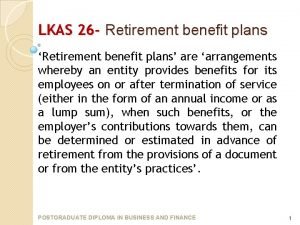Retirement Investing Chapter 9 pp 345 377 2019




























































































- Slides: 92

Retirement / Investing Chapter 9 pp. 345 -377 2019 National Income Tax Workbook™

Issues Addressed p. 345

Learning Objectives p. 345

Issue 1: Taxation of Life Insurance and Annuitiesp. 346 § Group-term life insurance premium provided by employer is: ▪ Excluded from income if the employer paid premium is for $50, 000 or less coverage ▪ Taxable if employer pays premium above the $50, 000 of coverage

Exclusion for Group-Term Insurance p. 346 § Must meet four conditions ▪ The death benefit is excludable ▪ INS provided to a group of employees ▪ INS provided under employer policy directly or indirectly ▪ $$ of INS provided is computed by formula

Group-Term INS is not: p. 346 § INS that does not provide general death benefits § INS on life of employee, spouse, or dependent § INS provides a permanent benefit (e. g. economic value)

10 -Employee Rule p. 347 § To qualify, employer must provide group-term INS to at least 10 FT employees § There are two exceptions to the 10 -employee rule

10 -Employee Rule Cont. 347 p. § For the two exceptions there are three types of employees who don’t count: ▪ If 65 or older ▪ PT employee <20 hrs/week, < 5 mo/yr ▪ Employed for less than specified period

Carried Directly or Indirectly p. 347 § Policy is considered to be carried by the employer if: ▪ The employer pays any cost of INS ▪ The employer arranges for premium payments and the premiums paid by at least 1 employee subsidize payments by at least one other employee

Costs based on IRS tables 348 p.

Examples to Illustrate 349 pp. 348 - § Ex. 9. 1 Carried by Employer § Ex. 9. 2 Not Carried by Employer § Ex. 9. 3 More than 1 Insurer § Ex. 9. 4 Insurance for Former Employee

Practitioner Note p. 349 § S-corp Shareholders ▪ The full cost of the group-term INS coverage is included in the >2% SH wages.

Key Employees p. 349 § 1. Officers with annual $$ of >$180, 000 (2019); or § 2. Individual ▪ Who owns 5% of business or ▪ 1% owner with annual pay >$150, 000 See 4 types of employees not counted ▪

Coverage over the Limit p. 349 § The monthly cost of INS above the $50 K paid by employer is included in employee wages. § Ex. 9. 5 Calculating the Cost of Coverage

Buying and Selling INS Policy p. 350 § Surrenders or sales generally trigger recognition of gross income. ▪ Surrender of Policy Ex. 9. 6 Outstanding loans can be an issue.

Viatical Settlements p. 350 § Viatical settlements are generally treated as paid upon death of TP § Payouts are made because TP is terminally or chronically ill.

Definitions p. 350 § Viatical settlement provider – an investor who buys life INS contracts § Terminally ill individual – a person reasonably expected to die within 24 months as certified by a physician

Definitions continued p. 351 § Chronically ill individual – person meeting one of three criteria as certified by med. pro. ▪ Unable to perform at least 2 activities of daily living ▪ Has a disability ▪ Requires supervision to protect from threats

Sale or Assignment of INS p. 351 § Sale by Transferee ▪ Generally capital gain § Taxation on Death of Insured ▪ Calculate basis ($ paid + premiums) § Transferor’s Taxation ▪ Rev. Rul. 2009 -13 ▪ Ex. 9. 7 Sale of Policy with $ Value

Annuities p. 352 An annuity is a contract that requires regular payments for more than 1 full year to the person entitled to received the payment (annuitant).

Qualified Annuities p. 353 § Generally these are subject to qualified retirement plan distribution rules. ▪ Qualified Periodic Payments Simplified Method Tables (Fig. 9. 2) Example 9. 8 Simplified Method

Annuities Continuedp. 354 § Qualified Nonperiodic Payments ▪ Example 9. 9 illustrates calculation of taxable portion of a “lump sum” payment.

Early Distribution Penalty p. 354 § Distributions to the TP before age 59. 5 are subject to a 10% additional tax penalty. ▪ Three general exceptions apply: - Substantially equal payments - Due to disability - Due to death of TP - 3 additional specific exceptions

Nonqualified Annuities p. 354 § Commercial annuities purchased directly by TP § Cross-reference NIIT ▪ Nonqualified annuity distributions are subject to NIIT.

Nonqualified Periodic Payments p. 355 § For these payments, TP calculates the tax-free amount of each annuity payment ▪ 6 step process ▪ Ex. 9. 10 Calculating the Tax-Free $$

Nonqualified Nonperiodic Payment p. 356 § Payment is allocated first part to earnings (taxable) and then to cost (basis) § Example 9. 11 Calculating the taxable portion § Note the special rules § Early Distribution Penalty… 10%

Issue 2: Types of Retirement Plans p. 357 § Three types of popular plans: ▪ SEP IRA ▪ SIMPLE IRA ▪ Profit-sharing

Simplified Employee Pension (SEP) p. 357 § SEP IRAs are relatively easy to establish, ▪ Must be established by the extended due date of the employer’s tax return filing date: - Self-employed – October 15, 20 xx

Simplified Employee Pension (SEP) p. 357 § Participation ▪ All employees 21 yrs old, ▪ And who provided services 3 of last 5 years (employer can reduce requirement) ▪ All eligible employees must participate - See list of excludible employees

Simplified Employee Pension (SEP) p. 357 § Contributions ▪ Only Employer makes $$ into each employee’s separate SEP IRA ▪ Vested immediately ▪ Max is lesser of 25% of comp or $56, 000 ▪ Watch for other plans combining to hit max of $56, 000.

Simplified Employee Pension (SEP) p. 358 § Example 9. 12 SEP contributions § Investments § Reporting § Self-Employed TPs ▪ Circular calculation ▪ Fig 9. 3 provides IRS Rate Table

Example 9. 13 Self-employed p. 359 § Jax’s profit $100, 000 § SEP plan says 10% of compensation § See Worksheet (Fig. 9. 4) for calculation of $8, 449 allowable SEP IRA contribution.

SUMMARY of SEP IRA p. 360

SIMPLE IRAs p. 360 § SIMPLE IRAs are plans for small businesses that have 100 or fewer employees who received $5, 000 or more in compensation. ▪ Note an employer can’t offer a SIMPLE IRA if other qualified plans are offered to employees.

SIMPLE IRAs p. 360 § Establishment ▪ Easy: Form 5305 -SIMPLE § Participation ▪ Any employee who received $5, 000 in any 2 prior years and is expected to earn at least $5, 000 - Employer can set lower $$ - Employer can set prior service

SIMPLE IRAs p. 361 § Employee Contributions ▪ ▪ Lesser of $13, 000 or 100% of comp If employee is over 50, $3, 000 catch up Contributions indexed for inflation 100% vested

SIMPLE IRAs p. 361 § Employer Contributions ▪ Mandated to make $$ ▪ Employer must decide which of two methods -nonelective 2% -matching of employee’s $, limit 3% of compensation ▪ 100% employee vested

SIMPLE IRAs p. 361 § Investment and Distributions ▪ Employee is responsible for decisions ▪ Employer does not have access or info relative to employee accounts ▪ Distributions allowed anytime - Early distributions 10% penalty - 25% if taken out within 2 yrs of start

SIMPLE IRAs p. 361 § Reporting ▪ SIMPLE IRA plan must annually provide employees a summary plan notice providing details ▪ No annual reports with government ▪ Distributions: 1099 -R

SIMPLE IRAs p. 362 § SE ed Taxpayers ▪ Net earnings from SE up to $13, 000 ▪ If > 50 $3, 000 catch up allowed ▪ Again, SEP IRA and SIMPLE IRA not allowed together

SUMMARY Figure 9. 6 p. 362

Profit-Sharing Plans p. 363 § Has a predetermined formula for allocating contributions § May have options for a 401(k) § Self-employed TPs can establish a solo 401(k)

Profit-Sharing Plans p. 363 § Establishing a Plan ▪ Adopt a written plan document ▪ Arrange a trust/account for plan’s assets ▪ Develop recordkeeping system ▪ Provide info to eligible employees to participate

Profit-Sharing Plans p. 363 § Participation – All Employees § Exclude some employees ▪ Not 21 ▪ Not completed length of service ▪ Covered by collective bargaining agreement ▪ Certain nonresident aliens

Profit-Sharing Plans p. 363 § Employer Contributions ▪ Simplest is % allocation of compensation ▪ Contributions can be made up to the extended due date of return (PLANNING) ▪ Limit is lesser of 100% of comp or $56 K ▪ No catch up $$ ▪ Vesting up to 6 years, BUT, if plan requires 2 years of service, then 100%

Profit-Sharing Plans p. 363 § Employee Contributions ▪ Participants can make nondeductible contributions - $19, 000 limit (2019) - $6, 000 catch up for 50 yr olds or older (not treated as catch up until over $19, 000 amount) - Ex. 9. 15 Annual Contribution Amount

Profit-Sharing Plans p. 364 § Investment and Distributions ▪ Investments can be held in a separate trust or account in the name of the plan ▪ Trustees can hold assets in separate accounts for each employee or hold in a consolidated account ▪ Participants can choose investment choices made available

Profit-Sharing Plans p. 364 § Investment and Distributions ▪ Distributions can be - Lump sum of the employee’s account - Roll over to an IRA or other retirement plan - Take periodic payments - Annuity or lifetime to not outlive $

Profit-Sharing Plans p. 364 § Cross Reference to Hardship withdrawals…some plans may allow § Reporting – the plan must keep employees informed of operations, any changes, provide opportunity to make decisions, and allow timely action.

Profit-Sharing Plans p. 365 § Individual Benefit Statement § Summary Annual Report § Nondiscrimination ▪ Cross-reference to discuss discrimination testing

Profit-Sharing Plans p. 365 § Self-Employed ▪ Solo 401(k) - Covers a business owner with no employees - Can cover owner’s spouse - Net earnings must come from personal services

Profit Sharing Plan Summary p. 366

Issue 3: Equity-Based Compensation p. 367 § This issue covers ▪ Incentive stock option plans ▪ Employee stock purchase plans ▪ Nonqualified stock compensation plans ▪ Phantom stock plan ▪ Stock appreciation rights

ESOPs p. 367 § Employee stock ownership plan ▪ Defined contribution – employer stock ▪ For closely held companies useful as a part of an ownership transition from founder to employees

ESOPs Continued p. 367 § Benefits of an ESOP ▪ Reward and motivate employees ▪ Closely held bus. can make $$ contributions to buy owner’s stock ▪ Tax deduction without cash outflow ▪ Bus. can sell stock to ESOP & use $ ▪ Ownership stays with employees

ESOPs Continued p. 367 § Benefits of an ESOP ▪ Contributions held in qualified retirement plan…no tax on transfer ▪ Bus. gets deduction within limits - 25% all participants comp ($280 K each) ▪ Income or gain deferred until paid out

ESOPs Continued p. 367 § Practitioner Note – S-corps § Distributions from plan can be delayed up to 6 years after an employee terminates and moves to another job.

Stock Compensation p. 367 § Not retirement plan § SCs are plans that give an employee the right to buy company stock at a set price. ▪ Statutory stock options (qualified) ▪ Non-statutory stock options (nonqualified)

Statutory Stock Options p. 368 § Employer can grant SSOs ▪ Exercise of the Option - Taxable event ▪ Disposition of the Stock - Possible Capital Gain treatment ▪ Practitioner Note – Annual Limitation ▪ Reporting

Non-statutory Stock Options p. 369 § Generally no tax consequence at employee or employer level § If able to determine FMV, then compensation for the employee

Non-statutory Stock Options p. 369 § Exercise the Option ▪ Employee has ordinary income and FICA taxes § Risk of Forfeiture ▪ If stock is subject to substantial risk of forfeiture, then not included in income until the risk is gone

Non-statutory Stock Options p. 369 § Risk of Forfeiture Conditions: ▪ Future performance or refraining from performance of substantial services by any individual; or ▪ Occurrence of a condition related to the purpose of the transfer, if the chance of forfeiture is substantial.

Non-statutory Stock Options p. 369 § Section 83(b) Election ▪ Elect to include the FMV of NSO in income ▪ If the election is made, any subsequent gain in value is generally capital gain income -PLANNING OPPORTUNITY

Non-statutory Stock Options p. 369 § Reporting ▪ Employer must report the excess of the FMV of stock received upon exercise of the NSO. - Employer reports on Form W-2, boxes 1, 3, and 5 (Identify with code “V” in box 12)

Non-statutory Stock Options p. 369 § Section 83(i) Deferral ▪ TCJA amended § 83 allowing qualified employees to defer paying income tax up to 5 years. IRS Notice 2018 -97 - See list for earliest of 5 dates

Non-statutory Stock Options p. 370 § Qualified Employee is any individual who isn’t excluded and agrees to meet IRS rules.

Non-statutory Stock Options p. 370 § Excluded Employee is: ▪ A 1% owner at anytime in the year ▪ The CEO or CFO (or was) ▪ Family-member relationship per § 318(a)(1) to CEO or CFO ▪ One of four highest compensated officers

Non-statutory Stock Options p. 370 § Qualified Stock § Eligible Corporation § Making the section 83(i) election ▪ Within 30 days after transfer or rights to employee ▪ Not available if section 83(b) made

Non-statutory Stock Options p. 370 § Making the section 83(i) election ▪ Employee cannot make election if the corporation issuing the stock purchased any of its outstanding stock subject to dates relative to substantial forfeiture.

Non-statutory Stock Options p. 371 § Notice Requirements ▪ Corporation is required to notify the employee of when the NSO would be first includable in gross income ▪ And notify employee’s eligibility to defer income on the NSO ▪ Notice 2018 -97 additional guidance

Phantom Stock Plan p. 371 § PSP is a nonqualified deferred comp arrangement where deferred amounts ($) are determined by reference to hypothetical phantom shares of the employer’s stock.

Phantom Stock Plan p. 371 § Employees may be entitled to: ▪ Stock valuations ▪ Or only the growth of the stock value between the award date and the time when the employee cashes out ▪ Dividends could also be included

Phantom Stock Plan p. 371 Practitioner Note § Phantom stock is generally excluded from income at the time of the grant. § Becomes ordinary income at cash out…also FICA due at vesting (at FMV; Stock’s appreciation is not)

Stock Appreciation Rights 371 p. § A stock appreciation right (SAR) is another compensation incentive to employees and independent contractors § Benefits only accrue if the stock appreciates

Stock Appreciation Rights 371 p. § Taxable event occurs when the SAR is exercised § The $$ received upon exercise of SAR is included in employee wages ▪ Employer has corresponding deduction ▪ If the employee fails to exercise, constructive receipt occurs at end of SAR term

Issue 4: Virtual Currency 372 p. § Virtual currency is created, transmitted, and verified by blockchain. § Blockchain is an internet-based decentralized network that stores encrypted data.

Issue 4: Virtual Currency 372 § Virtual currency has many benefits: ▪ Transfers can be immediate ▪ Fees are less than CCs ▪ Payers are more secure when conducting business ▪ There are no exchange rates p.

Issue 4: Virtual Currency 372 p. § IRS has issued limited guidance to date. § In 2018, IRS began a virtual currency campaign ▪ TPs not reporting income tax consequences of transactions

Virtual Currencyp. 372 § Obtaining virtual currency ▪ Through centralized exchanges ▪ Peer-to-peer exchange ▪ Miners of blockchain transactions can “earn” VC for solving the transaction ▪ Practitioner Note: Coins and Tokens

Virtual Currencyp. 373 § Additional ways to get VC ▪ ▪ Bitcoin ATM Initial Coin Offering Airdrop and Giveaway Purchasing Goods or Services

Virtual Currencyp. 373 § Current Tax Guidance ▪ IRS Notice 2014 -21 states VC is property, therefore, the general principles of property transactions apply.

Virtual Currencyp. 373 § Payment for Goods and Services – Seller ▪ A TP receiving VC as payment for good or services includes in income the FMV (in US $) of VC at the time of receipt. ▪ Basis is the issue to address.

Virtual Currencyp. 373 § Payment for Goods and Services – Buyer ▪ A TP using VC to pay for goods or services will have a capital gain or loss on the transaction.

Virtual Currencyp. 373 § Exchange or Sale ▪ Capital gain or loss ▪ Basis is needed to calculate § Compensation Income ▪ FMV when received is income ▪ Subject to FICA, FUTA, FIT, and SIT ▪ If a self-employed miner…SE tax

Virtual Currencyp. 373 § Reporting Issues ▪ W-2 for wages ▪ Form 1099 -MISC for $600 or more ▪ Form 1099 -K ▪ Practitioner Note: Foreign Accounts BOTTOM LINE: Records, Records !!!

Virtual Currencyp. 375 § Backup Withholding § Penalties § Practitioner Note: Tax Prep Software

Virtual Currencyp. 375 § 2016 TIGTA Audit Report ▪ Broadly raised awareness and asked for guidance - Small transactions: coffee - A bitcoin can be divided into 100, 000 pieces !!!!! - BASIS…BASIS

Virtual Currencyp. 375 § 2016 TIGTA Audit Report ▪ Tracking the Wage Transactions What’s the value? Who’s keeping records Employees Employers

Virtual Currencyp. 375 § 2016 TIGTA Audit Report ▪ Big issue - is a change coming to move from property to currency? Much left to be discovered

Virtual Currencyp. 376 § AICPA requested guidance in 2018 ▪ ▪ ▪ Expenses of obtaining VC Acceptable Valuation and Documentation Computation of Gains and Losses De Minimis Election Charitable Contribution Valuation Other issues

Virtual Currencyp. 377 § Congress on April 11, 2019 sent a bipartisan letter requesting IRS provide guidance on VC.

Questions? ?
 Indirect investing
Indirect investing Cs 377 umass
Cs 377 umass Proposta razoável para indemnização do dano corporal
Proposta razoável para indemnização do dano corporal Sid 377
Sid 377 Who invented bifocals
Who invented bifocals An/urn-25
An/urn-25 Keogh plan definition
Keogh plan definition Chapter 11 investing for your future
Chapter 11 investing for your future Chapter 10 basics of saving and investing
Chapter 10 basics of saving and investing Chapter 10 basics of saving and investing
Chapter 10 basics of saving and investing Chapter 6 saving and investing
Chapter 6 saving and investing Chapter 4 analyzing investing activities solutions
Chapter 4 analyzing investing activities solutions Chapter 17 investing in stocks
Chapter 17 investing in stocks Chapter 17 investing in stocks
Chapter 17 investing in stocks Chapter 13 investing in mutual funds
Chapter 13 investing in mutual funds Chapter 13 investing in bonds
Chapter 13 investing in bonds Chapter 12 investing in stocks
Chapter 12 investing in stocks Chapter 12 investing in stocks
Chapter 12 investing in stocks Compsci 345
Compsci 345 Digital clock in c++ using class
Digital clock in c++ using class Comp 345
Comp 345 Comp 345
Comp 345 Byk 346
Byk 346 Comp345
Comp345 Comp 345
Comp 345 Comp 345
Comp 345 Bienvenidos himno
Bienvenidos himno Fromme361
Fromme361 345 king william street adelaide
345 king william street adelaide Compsci 345
Compsci 345 Hbpc-345
Hbpc-345 Nuremberg code
Nuremberg code A-345-k
A-345-k Compsci 345
Compsci 345 Test 345
Test 345 Compsci 345
Compsci 345 Belinda doyle
Belinda doyle Ywca retirement fund
Ywca retirement fund William shakespare wife
William shakespare wife State of alaska retirement
State of alaska retirement Simple interest vocabulary
Simple interest vocabulary Bob carlson retirement watch
Bob carlson retirement watch Oncorretirees
Oncorretirees Montana teacher retirement calculator
Montana teacher retirement calculator Momiji health care society
Momiji health care society Retirement savings percentile
Retirement savings percentile Fort bragg retirement services
Fort bragg retirement services Parenting/expanding stage
Parenting/expanding stage Tcg retirement
Tcg retirement 52-6083699
52-6083699 Psea retirement calculator
Psea retirement calculator 8776441774
8776441774 Wv peia retirement
Wv peia retirement Opsrp retirement calculator
Opsrp retirement calculator Ucf retirement
Ucf retirement Ipers retirement options
Ipers retirement options Milwaukee county employees retirement system
Milwaukee county employees retirement system Md state retirement
Md state retirement Indian oil corporation retired employees
Indian oil corporation retired employees Livingston federal employee retirement planning
Livingston federal employee retirement planning Prudential retirement app
Prudential retirement app Petty cash retirement
Petty cash retirement Cash
Cash Iuoe cpf
Iuoe cpf Retirement plan limerick
Retirement plan limerick Usaid
Usaid Retirement planning warsaw
Retirement planning warsaw Conditional asset retirement obligation
Conditional asset retirement obligation Retirement planning fresno
Retirement planning fresno Planning for retirement windsor
Planning for retirement windsor Tag retirement
Tag retirement Retirement reimagined
Retirement reimagined Nmdc pension scheme
Nmdc pension scheme Alaska division of retirement and benefits
Alaska division of retirement and benefits Learning in retirement carleton university
Learning in retirement carleton university Ordinary repairs
Ordinary repairs Inprs
Inprs Fresno county employees retirement association
Fresno county employees retirement association The statement of cash flows helps users
The statement of cash flows helps users Take charge today the fundamentals of investing
Take charge today the fundamentals of investing The basic rule of a risk-to-return relationship is that the
The basic rule of a risk-to-return relationship is that the Option investing strategies
Option investing strategies Lesson twelve saving and investing
Lesson twelve saving and investing Growth investment definition
Growth investment definition Value investing meetup
Value investing meetup Everfi module 2 smart shopping answers
Everfi module 2 smart shopping answers Investing in megachallenges
Investing in megachallenges Investing activities meaning
Investing activities meaning Contrarian investor meaning
Contrarian investor meaning Derivative in investing
Derivative in investing Financing and investing cycle
Financing and investing cycle Accounting cash flow statement grade 12
Accounting cash flow statement grade 12 Investing activities meaning
Investing activities meaning
